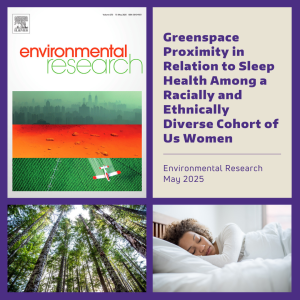Greenspace Proximity in Relation to Sleep Health Among a Racially and Ethnically Diverse Cohort of US Women
Citation
Gaston, S. A., Sweeney, M., Patel, S., Jennings, V., Bratman, G. N., Martinez-Miller, E., … & Jackson, C. L. (2025). Greenspace proximity in relation to sleep health among a racially and ethnically diverse cohort of US women. Environmental Research, 121698. doi.org/10.1016/j.envres.2025.121698
Getting good sleep is important for health, and spending time around nature may help. Green space can improve mood, reduce things that make sleep worse (like air pollution), and encourage exercise. But not many studies have looked at how green space and sleep are connected for diverse populations.
In this study, researchers looked at sleep and green space in over 47,000 women of different ages from varied racial, ethnic, and socioeconomic backgrounds. They found that women who lived in areas with more green space were more likely to report better sleep. The connection between green space and good sleep was strongest among women with more social advantages.
Abstract
 Sleep is essential for overall health. Greenspace may contribute to sleep health through, for instance, improving mood, reducing sleep disruptors (e.g., poor air quality), and promoting physical activity. Although greenspace likely differs across populations, few studies have included diverse populations.
Sleep is essential for overall health. Greenspace may contribute to sleep health through, for instance, improving mood, reducing sleep disruptors (e.g., poor air quality), and promoting physical activity. Although greenspace likely differs across populations, few studies have included diverse populations.
To investigate greenspace-sleep health associations, overall and by age, race and ethnicity, and socioeconomic status, we used data collected at enrollment (2003-2009) from women in the Sister Study (n=1,612 Hispanic/Latina, n=4,421 non-Hispanic (NH)-Black, and n=41,657 NH-White). Participants’ geocoded home addresses were linked to NASA’s Moderate Resolution Imaging Spectroradiometer Normalized Difference Vegetation Index data (250m resolution) to capture greenspace tertiles (further categorized as low/moderate vs. high). Participants reported seven sleep dimensions, which we assessed individually, along with a multidimensional sleep health measure (categories: favorable, moderate, poor). Adjusting for individual- and environmental/neighborhood-level characteristics, we used Poisson regression with robust variance to estimate prevalence ratios and 95% confidence intervals (PR[CI]). We tested for interaction and estimated age-, race and ethnicity-, and educational attainment category-specific associations.
Among participants (mean±SD age=55.7±9.0 years), those with low/moderate vs. high greenspace had a lower prevalence of favorable sleep (58% vs. 66%). After adjustment, low/moderate vs. high greenspace was associated with a 32% higher prevalence of moderate (PR=1.32 [1.27-1.38]) and 12% higher prevalence of poor (PR=1.12 [1.07-1.16]) vs. favorable sleep health. Magnitudes of associations were higher among NH-White women vs. minoritized racial-ethnic groups and women with higher vs. lower educational attainment.
Higher greenspace was associated with favorable sleep, with stronger associations among groups with more social advantages.
Highlights
- Few prior studies of greenspace and sleep included socially diverse samples.
- We investigated associations between greenspace proximity and sleep among US women.
- Effect modification by age, race-ethnicity, and socioeconomic status was assessed.
- Low/moderate greenspace proximity was associated with poorer sleep health.
- Associations were strongest among women with more social advantages.